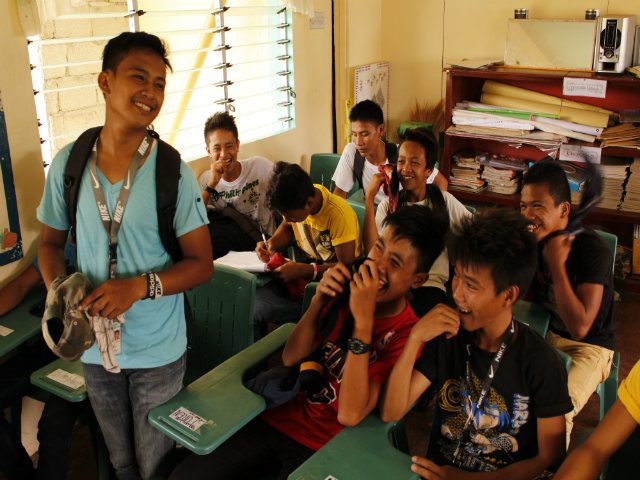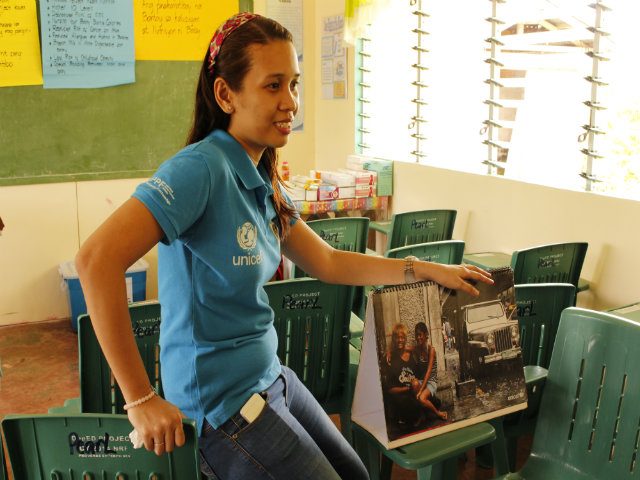SUMMARY
This is AI generated summarization, which may have errors. For context, always refer to the full article.

CAPIZ, Philippines – The boys stand up one by one to introduce themselves. They get past the part about their name and age without difficulty, but stammer when it gets to answering the last question: Who is your crush?
In that moment of hesitation, the other boys pounce. If the boy standing offers no name, the other boys will make a display of their disbelief, rattling off the name of a girl, sometimes a number of different girls.
If a boy does say an actual name, the others will cheer and hoot some more.
The light of the afternoon sun shining in their classroom makes it difficult to tell for sure, but it is a fair assumption to say that underneath their good-natured teasing and heckling, these teenage boys are actually blushing.
In the next room, a group of teenage girls are having the same discussion with much more subdued giggles, but with a similar shade of crimson rising to their cheeks.
“We start off the discussion on crushes to get the teens to open up, to warm up to the idea of sharing,” said Christine Sicad, 27, a peer counsellor and nurse trained by the Family Planning Organization of the Philippines (FPOP) to conduct teen sexuality lessons framed around actual everyday experiences of teenage life, like having a crush.
Judging from the laughter and their active participation, the approach is an effective one.
Sex education
It’s not every day that these teens get to talk openly about sex and the struggles of being a teenager in their classroom. Usually, they talk amongst themselves in huddles and whispers. They get their information – often tainted with misconceptions and myths – from their other friends who don’t know any more than they do.
Sex ed is a minefield of hearsay and speculation, where biology is a more of a subject to pass than the understanding of how the body functions.
This is the first time that the students of Maayon National High School are getting this kind of sex ed class in school. The FPOP, in partnership with UNICEF, has conducted medical missions in the school, but this particular mission includes family planning services for mothers and teen sexuality education for students.
Under the “Usapan Series,” a module designed by UNICEF and FPOP, issues such as teen pregnancy, and relationships are discussed and students are given an orientation on HIV 101.
It’s about time
“This is the time (high school) that girls get their period and when boys start having wet dreams. This is the start of the reproductive health years when these young adolescents need information to help them make sense of these hormonal changes,” said Dr. Anabelle Fajardo, executive director of FPOP.
According to the 2013 Young Adult Fertility and Sexuality Study (YAFS), among the more than 19,000 youth who were surveyed, 1 out of 3 Filipinos between the ages of 20-24 have had casual sex.
YAFS estimates that 1.4 million young people have engaged in casual sex, with about 600,000 having had FUBU or f*ck buddy.
Different generation, different needs
“The needs of young people are different now,” said Ronilo Tu, principal of Maayon National High School. Tu has spent many years in the education sector across different schools.
“Before, our major problem was over the bakod (going over the fence) to cut classes. Now, we encounter cyberbullying, violence and teen pregnancy. We educators, together with parents, need to adapt to these changes so we can address them,” said Tu.
Parents were informed about the family planning sessions and it was met with no opposition.
“The information that the students get here can be passed on to older brothers and sisters and even their parents. We see this as benefitting the entire community,” said Tu.
Under the Reproductive Health Law, comprehensive sexuality education taught in a way that matches the age of the students should be made part of the school curriculum. However, a training of teachers on sexuality modules will need to be done before this can be fully implemented.
Meanwhile, teen pregnancy rates continue to climb. The United Nations Population Fund (UNFPA) estimates that from 2000-2010 more than 60% of Filipinas became mothers before they were the age of 20.

Peer counsellors like Sicad, who give talks during medical missions, help bridge the information gap. To continue the teachings at these sexuality education classes, the FPOP has trained student leaders of the Maayon National High School to be school-based peer counsellors. The peer counsellors have a booth and take turns taking shifts to answer questions from the schoolmates.
There’s a lot more work to be done and today, Sicad has her hands full carrying the discussion forward from high school crushes to having relationships and the consequences of risky sexual behavior.
The boys tell her about their girlfriends not having enough time for them and about clingy girlfriends who won’t let them spend time with their buddies. They tell her about wanting to experiment with sex but not knowing how to doing it safely.
In between, Sicad will insert lessons about the importance of getting consent from one’s partner and respecting boundaries. Young, amiable, and in an affectionate inflection that the Illonggo dialect is famous for, Sicad sounds like a concerned hip older sister whose advice is to be welcomed rather than shunned.
“Some will admit to having engaged in sexual relations. Most, if not all of the time, their sexual encounters are unprotected. Some may have heard of condoms but many have not seen an actual one,” said Sicad.
It is challenging to get the teens to open up, but Sicad says that as a peer counsellor, she has to set the example. She has to be open in order to earn their trust. Even if it means having to tell them who your crush is, too?
It’s Sicad’s turn to blush now as she admits, “Yes. I also had to share the names of my crushes.” – Rappler.com
Add a comment
How does this make you feel?
There are no comments yet. Add your comment to start the conversation.